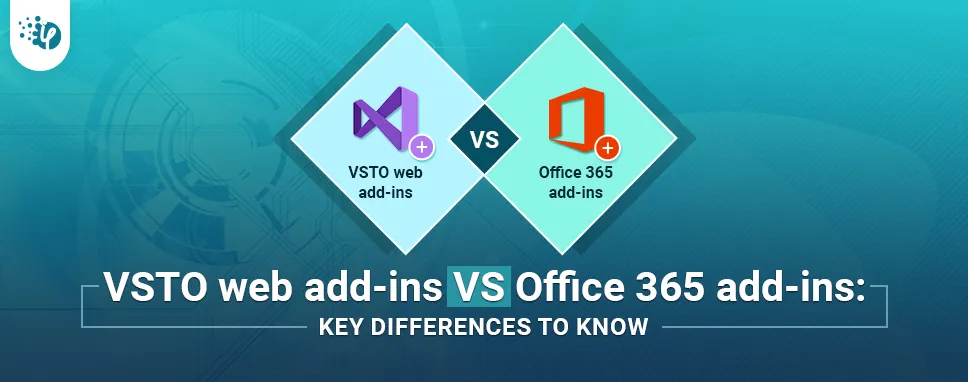Top Shift Left security Best Practices CTOs should consider
According to HackerOne, fixing a security issue after software is released can cost 30 times more than fixing it during development. Today, CTOs take a different approach. Shift...
Listening is fun too.
Straighten your back and cherish with coffee - PLAY !

Microsoft Office is a suite of popular productivity applications, including Outlook, Word, Excel, and PowerPoint among others. With the advent of cloud computing, Microsoft has introduced two development models for creating add-ins that enhance the functionality of Office applications i.e., VSTO web add-ins and Office 365 add-ins.
While both of these development models serve the same purpose, they differ in several key aspects, including their architecture, the platform they are built on, and their capabilities. In this blog, we will discuss the main differences between these two platforms.
Let's start with the fundamentals before delving deeper into the subject.
VSTO (Visual Studio Tools for Office) web add-ins are a type of Office Add-in that is developed using the VSTO technology and is designed to run in the web version of Microsoft Office, such as Office Online or Outlook on the web.
Traditionally, VSTO add-ins are developed using the .NET framework and are designed to run within the desktop version of Microsoft Office applications, such as Word, Excel, and PowerPoint. However, with the advent of Office 365 and web-based versions of Office applications, VSTO web add-ins have become increasingly popular. This prompted clients to hire ASP.NET MVC developers to meet their Add-in requirements.
VSTO web add-ins are built using HTML, JavaScript, and CSS and are hosted on a web server. They can be used to extend the functionality of web-based Office applications in the same way that traditional VSTO add-ins extend the functionality of desktop Office applications.
VSTO web add-ins can be used to add context menus, custom ribbons, and task panes to web-based Office applications. They may also be used to link with other web-based applications and APIs to give extra functionality to Office users. VSTO web add-ins are produced in Visual Studio and may be distributed to users via the Office Store or a corporate catalog.
This is how VSTO web add-ins provide a powerful way to extend the features of web-based Office apps and provide a seamless user experience across web and desktop-based Office apps.
Office 365 Add-ins are third-party applications that can be integrated into Microsoft Office applications such as Word, PowerPoint, Outlook, and Excel. These add-ins extend Office application capabilities by adding new features or services, automating repetitive tasks, or integrating with external services.
Office 365 Add-ins can be developed using a variety of coding languages and technologies, like HTML, CSS, JavaScript, .NET, and more. They are hosted either on the developer's own web server or on a cloud-based platform such as Azure.
The main purpose of Office 365 Add-ins development is to simplify work demands and speed up business data operations, whether in Excel, Outlook, Word, or PowerPoint.
These bespoke Office 365 Add-ins allow users to personalize their Office experience and optimize their workflows by interacting with external services and automating repetitive tasks.
Some examples of MS Office 365 Add-ins include:
It is a fantastic tool that allows users to sign and send documents for signature directly from a Word or Outlook.
This tool is a grammar and spelling checker integrated with Outlook or Word to provide real-time suggestions and corrections.
A tremendous project management tool that can be integrated with Outlook to manage tasks and track progress.
Microsoft Office Market share
All in all, custom Office 365 Add-ins development is a recommended way that offers users with personalized Office experience and streamlined workflows with integrated external services.
While both of these development models serve the same goal, they differ in various aspects, including the platform they are built on, their functionalities, and their architecture.
The VSTO web add-ins are built on the .NET framework, which is a popular platform for Windows desktop application development.Visual Studio is used by developers to produce VSTO add-ins, which are then deployed as COM add-ins. These add-ins are compatible with Microsoft Office 2010 and subsequent versions of the suite, and they interface with Office applications via a runtime library.
Office 365 add-ins, on the other hand, are written with web technologies like HTML, CSS, and JavaScript and hosted on web servers. These add-ins are compatible with Office 2013 and subsequent editions, as well as Office Online and Office for Mac. Add-ins for Office 365 may be built with any text editor or integrated development environment (IDE) that supports custom software development, such as Visual Studio Code, Sublime Text, or Atom.
VSTO web add-ins are .NET assemblies that operate within the Office application process. This means they are strongly connected with the Office program and can directly use its object model. VSTO add-ins may be written in any .NET language, including C#, Visual Basic.NET, and F#.
Office 365 add-ins, on the other hand, are designed as browser-based online apps. The JavaScript API for Office, which provides a collection of JavaScript libraries for dealing with Office documents and objects, is used by these add-ins to interface with the Office program. Any web development framework, including Angular, React, and Vue, may be used to create Office 365 add-ins.
VSTO web add-ins can offer a wide range of functionality within the Office program, such as custom ribbon tabs and buttons, task panes, custom form regions, and custom document actions. VSTO add-ins may also use the Office object model to change document content, create new documents, and interact with other Office functionalities.
Office 365 add-ins, on the other hand, are designed as browser-based online apps. The JavaScript API for Office, which provides a collection of JavaScript libraries for dealing with Office documents and objects, is used by these add-ins to interface with the Office program. Any web development framework, including Angular, React, and Vue, may be used to create Office 365 add-ins.
Here are some interesting facts about Microsoft Office platforms:
Office 365 add-ins, while not as tightly integrated with the Office application as VSTO add-ins, offer a number of advantages in terms of cross-platform compatibility and scalability. Since they are web-based, Office 365 add-ins may be used on a variety of devices and platforms, including Windows, macOS, iOS, and Android. Office 365 add-ins may also use cloud-based services like Microsoft Graph, which provides a consistent API for accessing data and functionality across numerous Microsoft services including OneDrive, SharePoint, and Teams.
Apart from these core differences, there are several other aspects to consider when deciding between VSTO web add-ins and Office 365 add-ins. The degree of programming experience necessary, the complexity of the add-in functionality, and the deployment and distribution procedure are all factors to consider. Because they are designed using the .NET framework and need knowledge of the COM and Office object models, VSTO add-ins often necessitate a higher degree of programming skill. Office 365 add-ins, on the other hand, may be created using more generally recognized and understood web development technologies.
Another point to think about is the complexity of the add-in functionality. VSTO add-ins are better suitable for complicated, highly integrated add-ins that require deep interaction with the Office program. Office 365 add-ins, on the other hand, are better suited for lightweight, web-based add-ins that can be readily installed. So, ready to hire office Add-ins developers? Let's connect and discuss your needs.
To summarize, there are significant differences between VSTO web add-ins and Office 365 add-ins that developers should be aware of before choosing which to utilize for their projects.
VSTO web add-ins are built on the .NET framework and are written with Visual Studio Tools for Office (VSTO). While Office 365 add-ins are built using web technologies such as HTML, CSS, and JavaScript.
VSTO com Add-ins are intended to function with Microsoft Office applications installed on a user's PC and need the installation of a COM add-in. VSTO web add-ins have limited cross-platform compatibility and can only be utilized on Windows PCs.
On the other hand, Bespoke Office Add-in are intended to function with Office apps running on a variety of platforms, including Windows, iOS, macOS, and Android. Office 365 add-ins provide improved cross-platform compatibility and are simply deployed via the Microsoft Office Store.
In conclusion, VSTO web add-ins are a fantastic solution for developers who are already familiar with the.NET framework and are working on Windows-based apps. Office 365 add-ins are a preferable option for developers who wish to create programs that can operate on numerous platforms and can be published easily via the Microsoft Office Store.

According to HackerOne, fixing a security issue after software is released can cost 30 times more than fixing it during development. Today, CTOs take a different approach. Shift...

A few years ago, companies built software first and thought about security later. Developers and security teams did not cooperate, and problems were fixed only after release. This activated DevSecOps vulnerabilities and many DevSecOps failures.

Security has always been a major concern. Your company spends millions on cybersecurity tools, and guess what? You’re still vulnerable. When you're working in the cloud, especially...